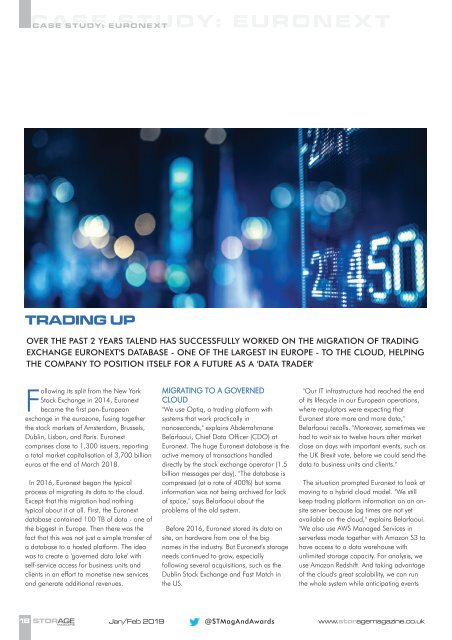ST1901
You also want an ePaper? Increase the reach of your titles
YUMPU automatically turns print PDFs into web optimized ePapers that Google loves.
CASE STUDY: EURONEXT STUDY: EURONEXT<br />
TRADING UP<br />
OVER THE PAST 2 YEARS TALEND HAS SUCCESSFULLY WORKED ON THE MIGRATION OF TRADING<br />
EXCHANGE EURONEXT'S DATABASE - ONE OF THE LARGEST IN EUROPE - TO THE CLOUD, HELPING<br />
THE COMPANY TO POSITION ITSELF FOR A FUTURE AS A 'DATA TRADER'<br />
Following its split from the New York<br />
Stock Exchange in 2014, Euronext<br />
became the first pan-European<br />
exchange in the eurozone, fusing together<br />
the stock markets of Amsterdam, Brussels,<br />
Dublin, Lisbon, and Paris. Euronext<br />
comprises close to 1,300 issuers, reporting<br />
a total market capitalisation of 3,700 billion<br />
euros at the end of March 2018.<br />
In 2016, Euronext began the typical<br />
process of migrating its data to the cloud.<br />
Except that this migration had nothing<br />
typical about it at all. First, the Euronext<br />
database contained 100 TB of data - one of<br />
the biggest in Europe. Then there was the<br />
fact that this was not just a simple transfer of<br />
a database to a hosted platform. The idea<br />
was to create a 'governed data lake' with<br />
self-service access for business units and<br />
clients in an effort to monetise new services<br />
and generate additional revenues.<br />
MIGRATING TO A GOVERNED<br />
CLOUD<br />
"We use Optiq, a trading platform with<br />
systems that work practically in<br />
nanoseconds," explains Abderrahmane<br />
Belarfaoui, Chief Data Officer (CDO) at<br />
Euronext. The huge Euronext database is the<br />
active memory of transactions handled<br />
directly by the stock exchange operator (1.5<br />
billion messages per day). "The database is<br />
compressed (at a rate of 400%) but some<br />
information was not being archived for lack<br />
of space," says Belarfaoui about the<br />
problems of the old system.<br />
Before 2016, Euronext stored its data on<br />
site, on hardware from one of the big<br />
names in the industry. But Euronext's storage<br />
needs continued to grow, especially<br />
following several acquisitions, such as the<br />
Dublin Stock Exchange and Fast Match in<br />
the US.<br />
"Our IT infrastructure had reached the end<br />
of its lifecycle in our European operations,<br />
where regulators were expecting that<br />
Euronext store more and more data,"<br />
Belarfaoui recalls. "Moreover, sometimes we<br />
had to wait six to twelve hours after market<br />
close on days with important events, such as<br />
the UK Brexit vote, before we could send the<br />
data to business units and clients."<br />
The situation prompted Euronext to look at<br />
moving to a hybrid cloud model. "We still<br />
keep trading platform information on an onsite<br />
server because lag times are not yet<br />
available on the cloud," explains Belarfaoui.<br />
"We also use AWS Managed Services in<br />
serverless mode together with Amazon S3 to<br />
have access to a data warehouse with<br />
unlimited storage capacity. For analysis, we<br />
use Amazon Redshift. And taking advantage<br />
of the cloud's great scalability, we can run<br />
the whole system while anticipating events<br />
18 STORAGE<br />
Jan/Feb 2019<br />
@STMagAndAwards<br />
www.storagemagazine.co.uk<br />
MAGAZINE

















